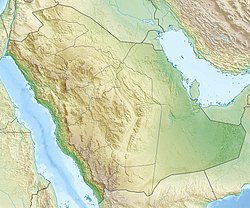Riyadh
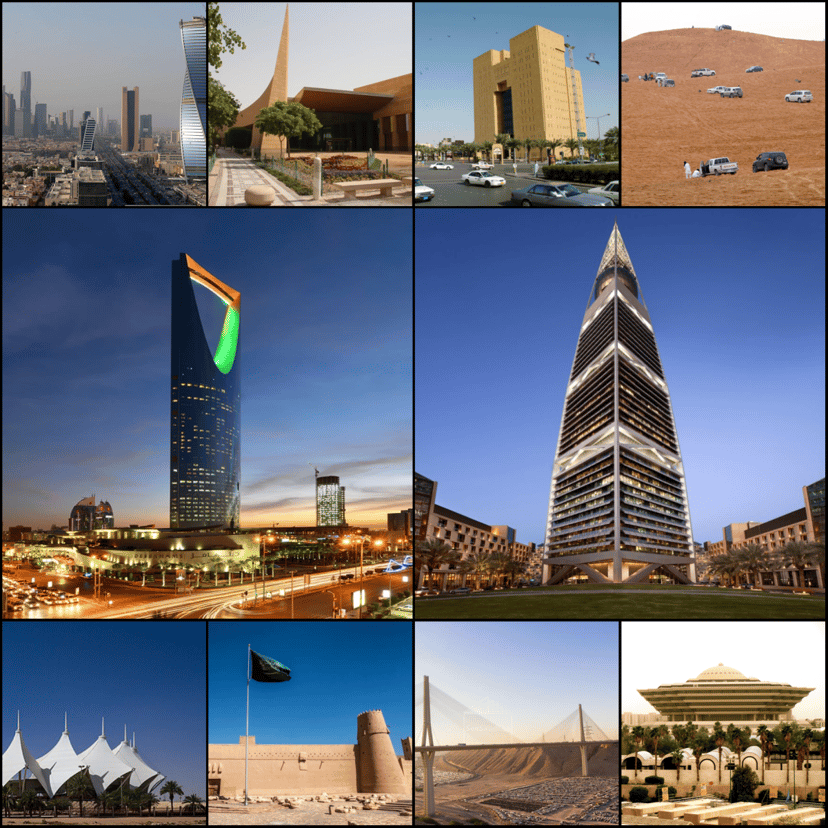
Riyadh

Riyadh الرياض | |
|---|---|
Capital city | |
| Coordinates:24°38′N 46°43′E [69] | |
| Country | |
| Region | Riyadh Region |
| Government | |
| • Riyadh Prince Governor | Faisal bin Bandar Al Saud |
| • Mayor | Tariq bin Abdul Aziz Al-Faris |
| Area | |
| • Total | 1,913 km2 (739 sq mi) |
| Elevation | 612 m (2,008 ft) |
| Population (2018)[1] | |
| • Total | 7,676,654 |
| • Density | 4,000/km2(10,000/sq mi) |
| Time zone | UTC+3 (AST) |
| • Summer (DST) | UTC+3 (AST) |
| Postal Code | (5 digits) |
| Area code(s) | +966-11 |
| Website | High Commission for the Development of Riyadh [70] Riyadh Municipality [71] |
Riyadh (/rɪˈjɑːd/; Arabic: الرياض, romanized: ar-Riyāḍ [ar.riˈjaːdˤ], Najdi pronunciation: [er.rɪˈjɑːðˤ]) is the capital of Saudi Arabia and Riyadh Province. It is the largest city in Saudi Arabia and one of the most populated cities in the Arab world, with a population of 6.9 million people as of 2018.[1] It is one of the largest Arab cities in area, at a size of 1,913 square kilometres (739 sq mi). Riyadh is located on the eastern part of the Najd plateau at about 600 metres (2,000 ft) above sea level.[2]
Riyadh is the political and administrative centre of Saudi Arabia and is the headquarters of the country's central government bodies, such as the Saudi Royal Court and the Council of Ministers of Saudi Arabia. Riyadh is of great economic importance, as it is the headquarters of many banks and major companies. It is also the location of the King Abdullah Financial District, one of the world's largest financial centres. Riyadh is one of the world's fastest-growing cities in population, with many immigrants.
The city is divided into 15 municipal districts, managed by the Municipality of Riyadh headed by the mayor of Riyadh, and the Royal Commission for Riyadh which is chaired by the governor of the Province, Faisal bin Bandar Al Saud. The current mayor is Tariq bin Abdul Aziz Al-Faris. Riyadh has been designated a global city.[3]
Riyadh الرياض | |
|---|---|
Capital city | |
| Coordinates:24°38′N 46°43′E [69] | |
| Country | |
| Region | Riyadh Region |
| Government | |
| • Riyadh Prince Governor | Faisal bin Bandar Al Saud |
| • Mayor | Tariq bin Abdul Aziz Al-Faris |
| Area | |
| • Total | 1,913 km2 (739 sq mi) |
| Elevation | 612 m (2,008 ft) |
| Population (2018)[1] | |
| • Total | 7,676,654 |
| • Density | 4,000/km2(10,000/sq mi) |
| Time zone | UTC+3 (AST) |
| • Summer (DST) | UTC+3 (AST) |
| Postal Code | (5 digits) |
| Area code(s) | +966-11 |
| Website | High Commission for the Development of Riyadh [70] Riyadh Municipality [71] |
History
Early history
During the Pre-Islamic era the city at the site of modern Riyadh was called Hajr (Arabic: حجر), and was reportedly founded by the tribe of Banu Hanifa.[4] Hajr served as the capital of the province of Al-Yamamah, whose governors were responsible for most of central and eastern Arabia during the Umayyad and Abbasid eras. Al-Yamamah broke away from the Abbasid Empire in 866 and the area fell under the rule of the Ukhaydhirites, who moved the capital from Hajr to nearby Al-Kharj. The city then went into a long period of decline. In the 14th century, North African traveler Ibn Battuta wrote of his visit to Hajr, describing it as "the main city of Al-Yamamah, and its name is Hajr". Ibn Battuta goes on to describe it as a city of canals and trees with most of its inhabitants belonging to the Bani Hanifa, and reports that he continued on with their leader to Mecca to perform the Hajj.
Later on, Hajr broke up into several separate settlements and estates. The most notable of these were Migrin (or Muqrin) and Mi'kal, though the name Hajr continued to appear in local folk poetry. The earliest known reference to the area by the name Riyadh comes from a 17th-century chronicler reporting on an event from the year 1590. In 1737, Deham ibn Dawwas, a refugee from neighboring Manfuha, took control of Riyadh.[5] Ibn Dawwas built a single wall to encircle the various oasis town in the area, making them effectively a single city. The name "Riyadh," meaning "gardens" refers to these earlier oasis towns.[6]
Third Saudi State
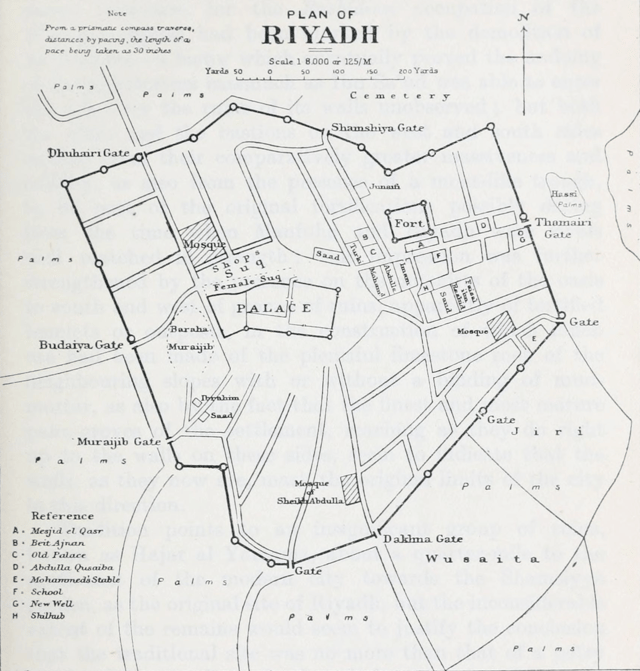
1922 map of Riyadh
In 1744, Muhammad ibn Abdel Wahhab formed an alliance with Muhammad ibn Saud, the ruler of the nearby town of Diriyah. Ibn Saud then set out to conquer the surrounding region with the goal of bringing it under the rule of a single Islamic state. Ibn Dawwas of Riyadh led the most determined resistance, allied with forces from Al Kharj, Al Ahsa, and the Banu Yam clan of Najran. However, Ibn Dawwas fled and Riyadh capitulated to the Saudis in 1774, ending long years of wars, and leading to the declaration of the First Saudi State, with Diriyah as its capital.[5]
The First Saudi State was destroyed by forces sent by Muhammad Ali of Egypt, acting on behalf of the Ottoman Empire. Ottoman forces razed the Saudi capital Diriyah in 1818.[5] They had maintained a garrison at Najd. This marked the decline of the House of Saud for a short time.[7] Turki bin Abdullah bin Muhammad became the first Amir of the Second Saudi State; the cousin of Saud bin Saud, he ruled for 19 years till 1834, leading to the consolidation of the area though they were notionally under the control of the Muhammad Ali, the Viceroy of Egypt.[7] In 1823, Turki ibn Abdallah chose Riyadh as the new capital.[8] Following the assassination of Turki in 1834, his eldest son Faisal killed the assassin and took control, and refused to be controlled by the Viceroy of Egypt. Najd was then invaded and Faisal taken captive and held in Cairo. However, as Egypt became independent of the Ottoman Empire, Faisal escaped after five years of incarceration, returned to Najd and resumed his reign, ruled till 1865, and consolidated the reign of House of Saud.[7]
Following the death of Faisal, there was rivalry among his sons which situation was exploited by Muhammad bin Rashid who took most of Najd, signed a treaty with the Ottomans and also captured Hasa in 1871. In 1889, Abdul Rahman bin Faisal, the third son of Faisal again regained control over Najd and ruled till 1891, whereafter the control was regained by Muhammad bin Raschid.[7]
Internecine struggles between Turki's grandsons led to the fall of the Second Saudi State in 1891 at the hand of the rival Al Rashid clan, which ruled from the northern city of Ha'il. The al-Masmak fort dates from that period.[8]
Abdul Rahman bin Faisal al-Saud had sought refuge among a tribal community on the outskirts of Najd and then went to Kuwait with his family and stayed in exile. However, his son Abdul Aziz retrieved his ancestral kingdom of Najd in 1902 and consolidated his rule by 1926, and further expanded his kingdom to cover "most of the Arabian Peninsula."[9] He named his kingdom as Saudi Arabia in September 1932[9] with Riyadh as the capital.[10] King Abdul Aziz died in 1953 and his son Saud took control as per the established succession rule of father to son from the time Muhammad bin Saud had established the Saud rule in 1744. However, this established line of succession was broken when King Saud was succeeded by his brother King Faisal in 1964. In 1975, Faisal was succeeded by his brother King Khalid. In 1982, King Fahd took the reins from his brother. This new line of succession is among the sons of King Abdul Aziz who has 35 sons; this large family of Ibn Saud hold all key positions in the large kingdom.[9]
Modern history
From the 1940s, Riyadh "mushroomed" from a relatively narrow, spatially isolated town into a spacious metropolis.[11] When King Saud came to power, he made it his objective to modernize Riyadh, and began developing Annasriyyah, the royal residential district, in 1950.[11] Following the example of American cities, new settlements and entire neighbourhoods were created in grid-like squares of a chess board and connected by high-performance main roads to the inner areas. The grid pattern in the city was introduced in 1953.[11] The population growth of the town from 1974-1992 averaged 8.2 percent per year.
The current mayor of Riyadh is Ibrahim Mohammed Al Sultan, an experienced transport official. He was appointed mayor in 2015.[12] Riyadh is now the administrative, and to a great extent the commercial hub of the Kingdom. According to the Saudi Real Estate Companion, most large companies in the country establish either sole headquarters or a large office in the city.[13] For this reason, there has been a significant growth in high rise developments in all areas of the city. Most notable among these is King Abdullah Financial District which is fast becoming the key business hub in the city.[14] Riyadh also has the largest all-female university in the world, the Princess Nora bint Abdul Rahman University.[15]
According to the Global Financial Centres Index, Riyadh ranked at 77 in 2016-2017. Though the rank moved up to 69 in 2018, diversification in the economy of the capital is required in order to avoid what the World Bank called a "looming poverty crisis" brought on by lingering low oil prices and rich state benefits.[16]
Since 2017, Riyadh has been the target of missiles from Yemen.[17] In March 2018, one person died as a result of a missile attack.[18] The number of missiles which targeted Riyadh are a small portion of the dozens of missiles fired from Yemen at Saudi Arabia due to the Saudi Arabian-led intervention in Yemen.[19] In April 2018, heavy gunfire was heard in Khozama;[20] this led to rumors of a coup attempt.[21]
Geography
Climate
Riyadh has a hot desert climate (Köppen Climate Classification BWh), with long, extremely hot summers and short, very mild winters. The average high temperature in August is 43.6 °C. The city experiences very little precipitation, especially in summer, but receives a fair amount of rain in March and April. It is also known to have dust storms during which the dust can be so thick that visibility is under 10 m (33 ft). On 1 and 2 April 2015, a massive dust storm hit Riyadh, causing suspension of classes in many schools in the area and cancellation of hundreds of flights, both domestic and international.
| Climate data for Riyadh (1985-2010) | |||||||||||||
|---|---|---|---|---|---|---|---|---|---|---|---|---|---|
| Month | Jan | Feb | Mar | Apr | May | Jun | Jul | Aug | Sep | Oct | Nov | Dec | Year |
| Record high °C (°F) | 31.5 (88.7) | 34.8 (94.6) | 38.0 (100.4) | 42.0 (107.6) | 45.1 (113.2) | 47.2 (117.0) | 48.0 (118.4) | 47.8 (118.0) | 45.0 (113.0) | 41.0 (105.8) | 38.0 (100.4) | 31.0 (87.8) | 48.0 (118.4) |
| Average high °C (°F) | 20.2 (68.4) | 23.4 (74.1) | 27.7 (81.9) | 33.4 (92.1) | 39.4 (102.9) | 42.5 (108.5) | 43.5 (110.3) | 43.6 (110.5) | 40.4 (104.7) | 35.3 (95.5) | 27.8 (82.0) | 22.2 (72.0) | 33.3 (91.9) |
| Daily mean °C (°F) | 14.4 (57.9) | 17.3 (63.1) | 21.4 (70.5) | 26.9 (80.4) | 32.9 (91.2) | 35.7 (96.3) | 36.8 (98.2) | 36.7 (98.1) | 33.5 (92.3) | 28.4 (83.1) | 21.5 (70.7) | 16.3 (61.3) | 26.8 (80.3) |
| Average low °C (°F) | 9.0 (48.2) | 11.2 (52.2) | 15.2 (59.4) | 20.4 (68.7) | 25.9 (78.6) | 28.0 (82.4) | 29.3 (84.7) | 29.2 (84.6) | 25.9 (78.6) | 21.2 (70.2) | 15.5 (59.9) | 10.6 (51.1) | 20.1 (68.2) |
| Record low °C (°F) | −2.2 (28.0) | 0.5 (32.9) | 4.5 (40.1) | 11.0 (51.8) | 18.0 (64.4) | 16.0 (60.8) | 23.6 (74.5) | 22.7 (72.9) | 16.1 (61.0) | 14.0 (57.2) | 7.0 (44.6) | 1.4 (34.5) | −2.2 (28.0) |
| Average rainfall mm (inches) | 12.5 (0.49) | 8.0 (0.31) | 24.0 (0.94) | 28.0 (1.10) | 4.9 (0.19) | 3.0 (0.12) | 3.7 (0.15) | 4.0 (0.16) | 0.1 (0.00) | 0.2 (0.01) | 0.9 (0.04) | 14.6 (0.57) | 103.9 (4.08) |
| Average rainy days | 6.1 | 4.3 | 9.4 | 11.3 | 3.3 | 0.0 | 0.1 | 0.2 | 0.0 | 0.5 | 3.3 | 6.3 | 44.8 |
| Average relative humidity (%) | 47 | 36 | 32 | 28 | 17 | 11 | 10 | 12 | 14 | 20 | 36 | 47 | 26 |
| Mean monthly sunshine hours | 212.4 | 226.6 | 219.8 | 242.3 | 287.7 | 328.2 | 332.1 | 309.2 | 271.6 | 311.4 | 269.2 | 214.3 | 3,224.8 |
| Percent possible sunshine | 63 | 71 | 59 | 63 | 70 | 80 | 80 | 77 | 74 | 87 | 82 | 65 | 72 |
| Source:"Jeddah Regional Climate Centre South West Asia"[72] .[22] | |||||||||||||
City districts
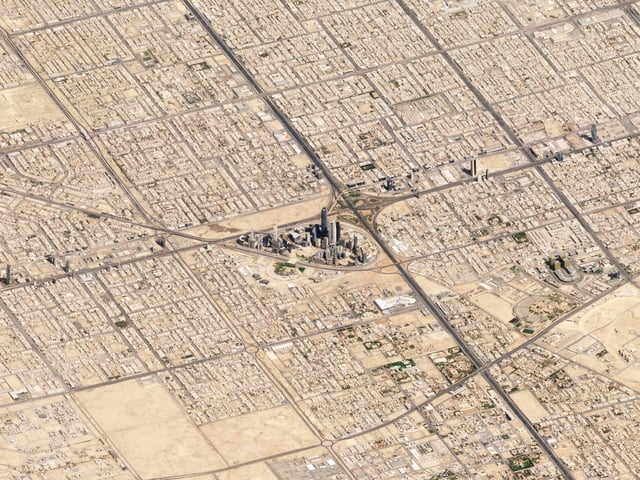
Satellite image of Riyadh
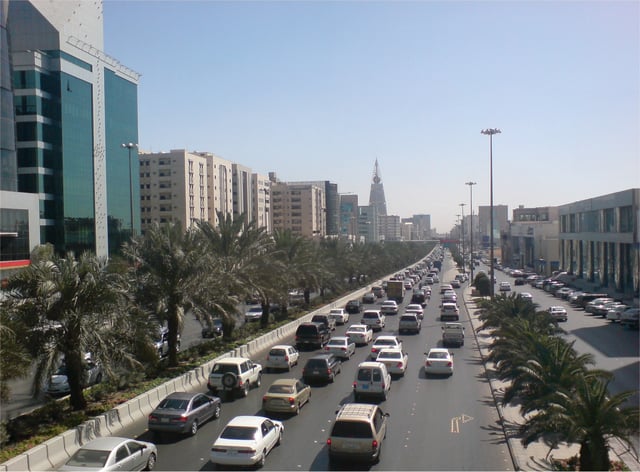
King Fahd Road
Riyadh is divided into fourteen branch municipalities,[23] in addition to the Diplomatic Quarter. Each branch municipality in turn contains several districts, amounting to over 130 in total, though some districts are divided between more than one branch municipality. The branch municipalities are Al-Shemaysi, Irqah, Al-Ma'athar, Al-Olayya, Al-Aziziyya, Al-Malaz, Al-Selayy, Nemar, Al-Neseem, Al-Shifa, Al-'Urayja, Al-Bat'ha, Al-Ha'ir, Al-Rawdha, and Al-Shimal ("the North"). Olaya District is the commercial heart of the city,[24] with accommodation, entertainment, dining and shopping options. The Kingdom Centre, Al Faisalyah and Al-Tahlya Street are the area's most prominent landmarks. The centre of the city, Al-Bathaa and Al-Deerah, is also its oldest part.
Some of the main districts of Riyadh are:
Al-Bat'ha[25] Al-Deerah (old Riyadh) Mi'kal Manfuha Manfuha Al-Jadidah (منفوحة الجديدة – "new Manfuha") Al-'Oud Al-Mansorah Al-Margab Salam Jabrah Al-Yamamah 'Otayyigah
Al-'Olayya & Sulaymaniyyah[26] Al-'Olayya Al-Sulaymaniyyah Al Izdihar King Fahd District Al-Masif Al-Murooj Al-Mugharrazat Al-Wurood
Nemar[25] Nemar Dharat Nemar Tuwaiq Hazm Deerab
Irqah[23] Irqah Al-Khozama
Diplomatic Quarter
Al-Shemaysi[27] Al-Shemaysi Eleyshah Syah Al-Nasriyyah Umm Sleym Al-Ma'athar Umm Al-Hamam (East)
Al-Ma'athar[28] Al-Olayya Al-Nakheel King Saud University main campus Umm Al-Hamam (East) Umm Al-Hamam (West) Al-Ma'athar Al-Shimali ("North Ma'athar") Al-Rahmaniyya Al-Muhammadiyya Al-Ra'id
Al-Ha'ir[23] Al-Ha'ir Al-Ghannamiyyah Uraydh
Al-'Aziziyyah[29] Ad Dar Al Baida Taybah Al Mansouriyah
Al-Malaz[30] Al-Malaz Al-Rabwah Al-Rayyan Jarir Al-Murabba'
Al-Shifa[31] Al-Masani' Al-Shifa Al-Mansuriyya Al-Marwah
Al-Urayja[32] Al-Urayja Al-Urayja Al-Wusta ("Mid-Urayja") Al-Urayja (West) Shubra Dharat Laban Hijrat Laban As-Suwaidi As-Suwaidi (West) Al-Badi'a Dahrat Al-Badi'a Sultanah
Al-Shemal[33] Al-Malga Al-Sahafa Hittin Al-Wadi Al-Ghadir Al-Nafil Imam Muhammad ibn Saud University main campus Al-Qayrawan Al-Aqiq Al-Arid
Al-Naseem[34] Al-Naseem (East) Al-Naseem (West) As-Salam Al-Manar Al-Rimayah Al-Nadheem
Al-Rawdhah[23] Al-Rawdhah Al-Qadisiyah Al-M'aizliyyah Al-Nahdhah Gharnatah (Granada) Qortubah (Cordoba) Al-Hamra Al-Qouds
Al-Selayy[35] Al-Selayy Ad Difa' Al Iskan Khashm Al-'Aan Al-Sa'adah Al-Fayha Al-Manakh
King Abdullah Financial District
Demographics
| Historical population | ||
|---|---|---|
| Year | Pop. | ±% |
| 1918 | 18,000 | — |
| 1924 | 30,000 | +66.7% |
| 1944 | 50,000 | +66.7% |
| 1952 | 80,000 | +60.0% |
| 1960 | 150,000 | +87.5% |
| 1972 | 500,000 | +233.3% |
| 1978 | 760,000 | +52.0% |
| 1987 | 1,389,000 | +82.8% |
| 1992 | 2,776,000 | +99.9% |
| 1997 | 3,100,000 | +11.7% |
| 2009 | 4,873,723 | +57.2% |
| 2013 | 5,899,528 | +21.0% |
| 2016 | 6,506,700 | +10.3% |
| 2017 | 7,676,654 | +18.0% |
| Source: Census data | ||
The city had a population of 40,000 inhabitants in 1935 and 83,000 in 1949.[36] The city has experienced very high rates of population growth, from 150,000 inhabitants in the 1960s to over 5 million, according to the most recent sources. As of 2017, the population of Riyadh is composed of 64.19% Saudis, while non-Saudis account for 35.81% of the population. Indians are the largest minority population at 13.7%, followed by Pakistanis at 12.4%.[37]
Landmarks and architecture
Vernacular architecture of Old Riyadh
The old town of Riyadh within the city walls did not exceed an area of 1 km2, and therefore very few significant architectural remnants of the original walled oasis town of Riyadh exist today. The most prominent is the Masmak fort and some parts of the original wall structure with its gate which have been restored and reconstructed. There are also a number of traditional mud-brick houses within these old limits, but they are for the most part dilapidated.
Expansion outside the city walls was slow to begin with, although there were some smaller oases and settlements surrounding Riyadh. The first major construction beyond the walls was King Abdulaziz's Murabba Palace. It was constructed in 1936, completed in 1938, and a household of 800 people moved into it in 1938. The palace is now part of a bigger complex called The King Abdulaziz Historical Centre.
There are other traditional villages and towns in the area around traditional Riyadh which the urban sprawl reached and currently encompasses. These include Diriyah, Manfuha and Wadi Laban. Unlike in the early days of development in Riyadh during which vernacular structures were razed to the ground without consideration, there is a new-found appreciation for traditional architecture. The Saudi Commission for Tourism and National Heritage is making efforts to revitalize the historic architecture in Riyadh and other parts of the kingdom.[38]
Ain Heet Cave
Ain Heet cave has an underground lake (150 meters deep) situated at the face of Mount Al Jubayl in Wadi As Sulay in a small village called Heet in Riyadh. Between Riyadh and Al Kharj road, it is one of the easily accessible caves in the area of Riyadh.
Archaeological sites
The archeological sites at Riyadh which are of historical importance, in which the Municipality of Riyadh is involved, are the five old gates on the old walls of Riyadh. These are the eastern gate of Thumaira, the northern gate of Al-Suwailen, the southern gate of Dukhna, the western gate of Al-Madhbah and the south-western gate of Shumaisi. There are also four historic palaces, which are the Musmak Palace, the Al-Murabba Palace (palace of King Abdul Aziz), Prince Muhammad bin Abdul-Rahman and the Shamsiya Palace.[39]
Turaif district
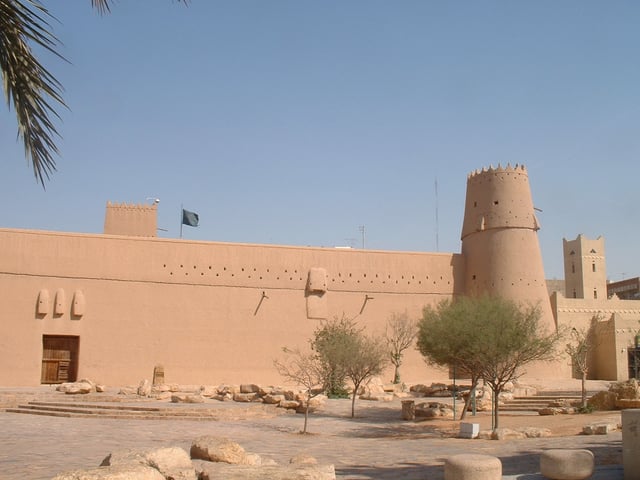
Masmak Fortress
The Turaif district, is another important archaeological site inscribed in UNESCO World Heritage List on July 31, 2010.[40][41] It was founded in the 15th century bearing an architectural style of Najdi.[42] There are some Historic palaces and monuments in Al-Turaif district include: Salwa Palace, Saad bin Saud Palace, The Guest House and At-Turaif Bath House, and Imam Mohammad bin Saud Mosque.[43]
Masmak Fortress
This fortress was built around 1865 under the reign of Mohammed ibn Abdullah ibn Rasheed (1289-1315 AH), the ruler of Ha'il to the north, who had wrested control of the city from the rival clan of Al Saud. In January 1902 Ibn Saud, who was at the time living in exile in Kuwait, succeeded in capturing the Masmak fortress from its Rashid garrison. The event, which restored Saudi control over Riyadh, has acquired almost mythical status in the history of Saudi Arabia. The story of the event is often retold, and has as its central theme the heroism and bravery of the King Abd Abdulaziz Ibn Saud. The Masmak Fortress is now a museum and is in close proximity to the Clock Tower Square, also known to English-speaking residents as Chop Chop Square, referring to the capital punishment that takes place there.
Contemporary architecture
Kingdom Centre
Designed by the team of Ellerbe Becket and Omrania, the tower is built on 94,230 square metres of land. The Kingdom Centre is owned by a group of companies including Kingdom Holding Company, headed by Al-Waleed bin Talal, a prince of the Saudi royal family, and is the headquarters of the holding company. The project cost 2 billion Saudi Arabian Riyals and the contract was undertaken by El-Seif. The Kingdom Centre is the winner of the 2002 Emporis Skyscraper Award, selected as the "best new skyscraper of the year for design and functionality". A three-level shopping centre, which also won a major design award, fills the east wing. The large opening is illuminated at night in continuously changing colours. The shopping centre has a separate floor for women only to shop where men are not allowed to enter.
The Kingdom Tower has 99 stories and is the third tallest structure in the country (behind Makkah Royal Clock Tower Hotel in Mecca and Burj Rafal in Riyadh), rising to 300 m. A special aspect of the tower is that it is divided into two parts in the last one third of its height and is linked by a sky-bridge walkway, which provides stunning views of Riyadh.[44]
Burj Rafal Hotel Kempinski
Burj Rafal, located on King Fahd Road, is the tallest skyscraper in Riyadh at 307.9 meters (1,010 feet) tall. The tower was designed and engineered by P & T Group. Construction began in 2010 and was completed 2014. The project was considered a success, with 70% of the residential units already sold by the time the skyscraper was topped out. The tower currently contains 474 residential condominium units and a 349-room 5-star Kempinski hotel.[45]
Burj Al Faisaliyah

Al Faisaliyah Centre
Al Faisaliyah Centre (Arabic: برج الفيصلية) is the first skyscraper constructed in Saudi Arabia, and is the third tallest building in Riyadh after the Burj Rafal and the Kingdom Centre. The golden ball that lies atop the tower is said to be inspired by a ballpoint pen, and contains a restaurant; immediately below this is an outside viewing deck. There is a shopping centre with major world brands at ground level. Al Faisaliyah Centre also has a hotel at both sides of the tower while the main building is occupied by offices run by different companies. The Al Faisaliyah Tower has 44 stories.[44] It was designed by Foster and Partners.
Riyadh TV Tower
The Riyadh TV Tower is a 170 meter high television tower located inside the premises of the Saudi Ministry of Information. It is a vertical cantilever structure which was built between 1978–81. The first movie made in 1983 by the TV tower group and named "1,000 Nights and Night" had Mohammed Abdu and Talal Mmdah as the main characters. At that time, there were no women on TV because of religious restrictions. Three years later, Abdul Khaliq Al-Ghanim produced a TV series called "Tash Ma Tash," which earned a good reaction from audiences in the Arab states of the Persian Gulf. This series created a media revolution back in the 1980s.[46]
Museums and collections
In 1999, a new central museum was built in Riyadh, at the eastern side of the King Abdul Aziz Historical Centre. The National Museum of Saudi Arabia combined several collections and pieces that had up until then been scattered over several institutions and other places in Riyadh and the Kingdom. For example, the meteorite fragment known as the "Camel's Hump", recovered in 1966 from the Wabar site, that was on display at the King Saud University in Riyadh became the new entry piece of the National Museum of Saudi Arabia.
The Royal Saudi Air Force Museum, or Saqr Al-Jazira, is located on the East Ring Road of Riyadh between exits 10 and 11. It contains a collection of aircraft and aviation-related items used by the Royal Saudi Air Force and Saudia (Saudi Arabian Airlines).
Sports

King Fahd International Stadium
Football is the most popular sport in Saudi Arabia. The city hosts four major football clubs, Al Hilal was established in 1957 and has won 15 championships in the Saudi Premier League.[47] Al-Nasr club is another team in the top league that has many supporters around the kingdom. It was established in 1955, and has been named champion of the Saudi League 7[48] times. Another well-known club, Al-Shabab, was established in 1947 and holds 6 championships. There is also Al-Riyadh Club, which was established in 1954, as well as many other minor clubs.[49]
The city also has several large stadiums such as King Fahd International Stadium with a seating capacity of 70,000.[49] The stadium hosted the FIFA Confederations Cup three times, in the years 1992, 1995 and 1997. It also hosted the FIFA U-20 World Cup in 1989,[49] and Prince Faisal bin Fahd Stadium (Al-Malaz Stadium) that is currently used mostly for football matches. The stadium has a capacity of 22,500 people.
The city's GPYW Indoor Stadium served as host arena for the 1997 Asian Basketball Championship, where Saudi Arabia's national basketball team reached the Final Four.
On February 29, 2020, the world's richest thoroughbred horse race will take place at the King Abdulaziz Racetrack in Riyadh. The Saudi Cup is a new race for thoroughbreds aged four and up, to be run at weight-for-age terms over 1800m (9f). The prize money is US$20m with a prize of US$10m to the winner and prize money down to tenth place. The Saudi Cup is perfectly positioned between the Pegasus World Cup and the Dubai World Cup to attract the best horses from around the world to compete for horse racing's richest prize. Putting the Kingdom of Saudi Arabia on the international horseracing map, the Saudi Cup will also hold an undercard of international races on both dirt and the new turf course.
Transportation
Airport
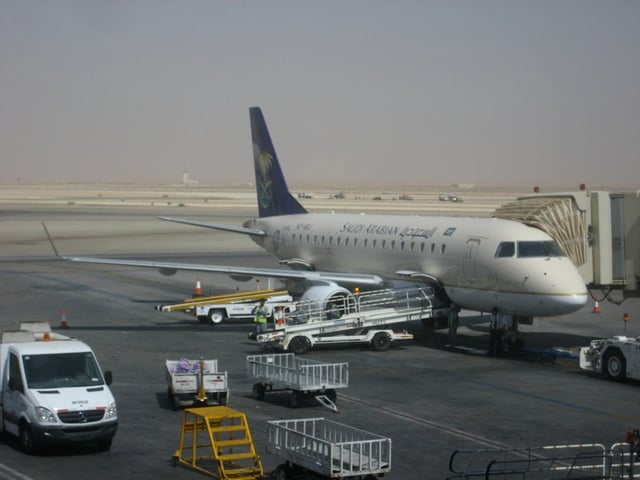
Saudi Arabian Airlines ERJ-170 at Riyadh King Khalid International Airport
Riyadh's King Khalid International Airport (KKIA), located 35 kilometers north from the city centre, is the city's main airport, and serves over 17 million passengers a year.[50] Plans are being made to expand the airport to accommodate 35 million passengers, given that the airport was only built for 12 million passengers annually.[50] A possible new airport is on the table. It is one of the largest airports in the world by land area.
Roads
The city is served by a modern major highway system. The main Eastern Ring Road connects the city's south and north, while the Northern Ring Road connects the city's east and west. King Fahd Road runs through the centre of the city from north to south,[51] in parallel with the East Ring Road. Makkah Road, which runs east-west across the city's centre, connects eastern parts of the city with the city's main business district and the diplomatic quarters.
Railways and metro
Saudi Railways Organization operates two separate passenger and cargo lines between Riyadh and Dammam, passing through Hofuf and Haradh. Two future railway projects, connecting Riyadh with Jeddah and Mecca in the western region, and connecting Riyadh with Buraidah, Ha'il and Northern Saudi Arabia are underway.[52] A metro has also been approved, with six lines planned with a scheduled opening in 2019.[53]
Buses
The metro system will be integrated with an 85 kilometres (53 mi), three-line bus rapid transit (BRT) network.[54]
The main charter bus company in the kingdom, known as the Saudi Public Transport Company (SAPTCO), offers trips both within the kingdom and to its neighboring countries, including Egypt (via ferries from Safaga or Nuweiba) and Arab states of the Persian Gulf.[55]
Media
The 170 m (560 ft) Riyadh TV Tower, operated by the Ministry of Information, was built between 1978 and 1981. National Saudi television channels Saudi TV1, Saudi TV2, Saudi TV Sports, Al-Ekhbariya, ART channels network operate from here.[56] Television broadcasts are mainly in Arabic, although some radio broadcasts are in English or French. Arabic is the main language used in television and radio but radio broadcasts are also made in different languages such as Urdu, French, or English. Riyadh has four Arabic newspapers; Asharq Al-Awsat (which is owned by the city governor), Al Riyadh, Al Jazirah and Al-Watan, two English language newspapers; Saudi Gazette and Arab News, and one Malayalam language newspaper, Gulf Madhyamam.[56]
Development projects
In 2019, King Salman launched a plan to implement 1281[57] development projects in Riyadh. The project is planned to cost around US$22 billion.[58] The main goal of the plan is to improve the infrastructure, transportation, environment and other facilities in Riyadh and the surrounding area.[58] In the framework of Saudi Vision 2030, the plan will take care of constructing 15 housing units, building a huge museum, establishing an environmental project, sport areas, medical cities, educational facilities and others.[58] This includes the establishment of 14 electricity projects, 20 sewage projects, 10 housing areas, 66 trading and industrial areas, a number of lakes covering 315,000 square meters and well-advanced sport cities.[57] Alongside with the development project and in the aim of enhancing the artistic movement of the city, 1000 pieces of art are planned to be publicly displayed in the city by the end of 2030.[59] In the framework of Riyadh's development projects, an amount of SR 604 million has been awarded to develop and construct roads of Riyadh.[60]
Events and Festivals
Jenadriyah
Jenadriyah is an annual festival that has been held in Riyadh for 33 times. It hosts a number of cultural and traditional events, such as camel race, poetry reading and others.[61]
Riyadh International Book Fair
It is one of the largest book fairs in the MENA region. It is usually held between March and April and it hosts a wide range of Saudi, Arab and international publishers.[62]
Riyadh Season
In the framework of the recent Saudi endeavor to promote tourism in the country, Riyadh Season will be held as part of the Saudi Seasons initiative. The season will take place in October 2019 and will last until December 2019. It will host a wide range of sports, musical, theatrical, fashion shows, circus and various other entertainment activities.[63]

